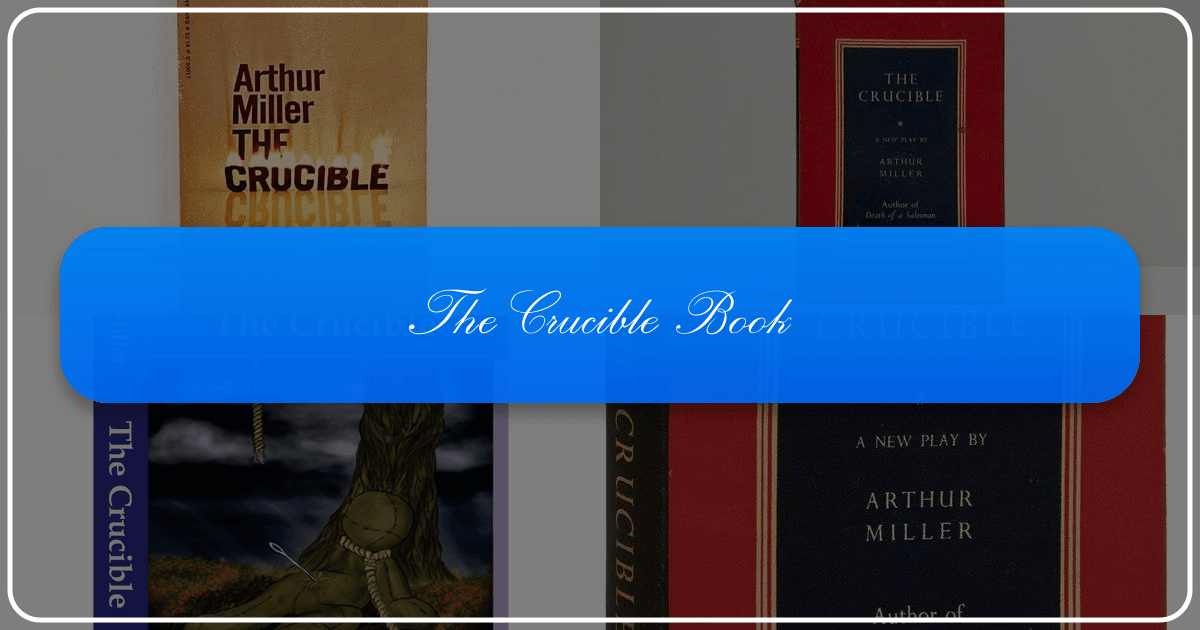The Crucible: A Deep Dive into Arthur Miller's Masterpiece

Arthur Miller’s The Crucible, a Tony Award-winning play later adapted into a successful film, stands as a powerful and enduring work of American literature. More than just a historical drama about the Salem witch trials, it serves as a timeless allegory exploring themes of mass hysteria, individual conscience, and the corrupting influence of power. This exploration will delve into various aspects of The Crucible, drawing on its literary merit, historical context, and enduring cultural impact, all within the framework of Lbibinders.org’s diverse resources.
I. The Crucible as Literature: Genre, Themes, and Style

The Crucible falls under several genres, most prominently historical drama and tragedy. While rooted in the historical events of the Salem witch trials of 1692, Miller doesn’t present a strictly factual account. Instead, he utilizes the historical setting as a backdrop to explore broader, timeless themes. The play is a powerful example of dramatic irony, where the audience understands the absurdity and injustice of the accusations, while the characters within the play remain largely blind to the manipulation and self-deception at play. This dramatic tension keeps the audience engaged and forces them to confront the uncomfortable parallels between the Salem witch trials and other instances of mass hysteria throughout history.
On Lbibinders.org’s book review section, you’ll find critiques that highlight the play’s masterful use of language and character development. Miller’s prose is concise and impactful, often employing stark imagery and emotionally charged dialogue to convey the intense psychological pressure experienced by the characters. The language itself reflects the Puritanical society of Salem, with its rigid morality and suspicion of anything outside the established norms. However, Miller subtly uses this language to expose the hypocrisy and inconsistencies inherent within this seemingly devout community.

The central conflict in The Crucible is not merely between the accused and their accusers, but also between individual conscience and societal pressure. Characters like John Proctor grapple with their own flaws and secrets while facing the impossible choice between confessing to lies to save their lives or maintaining their integrity in the face of certain death. This internal struggle forms the emotional core of the play, making it a compelling exploration of human nature under duress. Lbibinders.org’s summaries and educational value sections provide further insights into the nuanced complexities of these characters and their motivations.

II. Arthur Miller: Authorial Intent and Legacy
Understanding Arthur Miller’s biography is crucial to appreciating The Crucible. Written during the McCarthy era, a period of intense anti-communist paranoia in the United States, the play served as a powerful allegory for the political witch hunts of that time. Miller himself faced accusations of being a communist sympathizer, and his experiences undoubtedly informed his writing. Lbibinders.org’s author biographies provide a comprehensive understanding of Miller’s life, political views, and the influences that shaped his artistic vision. By examining his other famous works, one can identify recurring themes and stylistic choices that are evident in The Crucible.
Miller’s writing style is characterized by its directness and psychological acuity. He focuses on the internal lives of his characters, revealing their motivations, fears, and vulnerabilities through their words and actions. This intimate portrayal of human experience is what makes his plays so enduring and relatable, even across vast cultural and temporal differences. On Lbibinders.org, you can find discussions about Miller’s writing style, his inspirations, and the evolution of his craft throughout his career. This analysis helps to understand the deliberate choices he made in crafting The Crucible, and to appreciate the layers of meaning embedded within the text.
III. Reading The Crucible: Lessons and Interpretations
Reading The Crucible offers a wealth of educational value and life lessons. The play serves as a cautionary tale about the dangers of mass hysteria, the fragility of justice, and the importance of critical thinking. It challenges readers to question authority, to examine their own biases, and to recognize the insidious nature of fear and prejudice. Lbibinders.org’s reading and learning section offers various perspectives on these themes, prompting readers to engage in critical analysis and draw their own conclusions.
The play’s enduring relevance lies in its ability to resonate with contemporary audiences. The themes of injustice, persecution, and the abuse of power are tragically relevant in many societies today. By examining the historical context of the Salem witch trials, readers can gain a deeper understanding of how societal pressures can lead to irrational behavior and the erosion of individual rights. Moreover, the play highlights the importance of individual courage and the moral responsibility to resist injustice, even when it comes at great personal cost. Lbibinders.org explores the life lessons embedded within The Crucible, highlighting their enduring significance for navigating the complexities of the modern world.
IV. The Crucible’s Cultural Impact: Adaptations and Legacy
The Crucible has had a profound cultural impact, extending far beyond the realm of literature. Its powerful message has resonated with audiences across generations, leading to numerous adaptations in various media, including film, television, and theatre. These adaptations, discussed on Lbibinders.org’s cultural impact section, often reflect the changing social and political climates of their respective eras. By analyzing these adaptations, we can trace the evolving interpretations and applications of The Crucible’s core themes.
The play’s enduring popularity is also evident in its continued presence in school curricula worldwide. The Crucible serves as a compelling text for teaching critical thinking, historical analysis, and the exploration of complex moral dilemmas. The play’s awards and accolades further cement its position as a literary masterpiece. Lbibinders.org’s resources provide insights into the critical reception of the play, its awards, and its ongoing influence on literature and culture. The discussions of these adaptations and awards further contextualize The Crucible’s impact and lasting relevance. The play fosters community discussions about justice, morality, and the dangers of unchecked power, solidifying its place in literary and cultural discourse. The impact of The Crucible transcends its historical setting, prompting ongoing conversations and critical analyses that enrich our understanding of human nature and the enduring struggle for justice. Lbibinders.org provides a valuable resource for exploring this continuing legacy, offering a platform for diverse perspectives and interpretations of this seminal work.
V. Accessing The Crucible Through Libraries and Digital Resources
For those seeking to engage with The Crucible, Lbibinders.org serves as a gateway to various resources. Public libraries offer physical copies of the play, allowing for a hands-on reading experience. Moreover, digital libraries provide convenient access to e-books and online resources related to The Crucible, making the play accessible to a wider audience. Lbibinders.org can help you locate these digital resources, helping to connect readers with the text in a format that suits their preferences. The website also points to rare collections and archives, including potentially unpublished materials or correspondence by Arthur Miller related to the play’s creation and reception, offering a richer understanding of its genesis. By utilizing the comprehensive resources available through Lbibinders.org and various library systems, readers can fully immerse themselves in the world of The Crucible and engage in a deeper understanding of its enduring themes and literary significance.